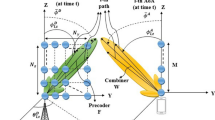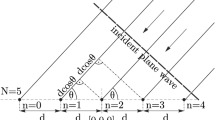Abstract
Aiming at the problem of beamforming performance degradation under the coherent signals model, this paper proposes an adaptive beamforming algorithm based on the virtual array. Compared with previous work, the creative construction of virtual arrays in this paper allows the algorithm to ensure strong coherent signal processing and superior output performance with no degradation in coherence capability. The proposed algorithm firstly constructs a virtual array symmetric to the physical array to form a virtual antenna array model; secondly, a full-rank covariance matrix is obtained by matrix reconstruction; then, the direction vector and power of the signals are estimated; finally, the estimated parameters are used to reconstruct the interference plus noise covariance matrix (INCM) and calculate the weight vector. Simulation analysis verifies the superiority of the algorithm and the validity of theoretical analysis.








Similar content being viewed by others
References
Zhang Y, Li W, Chen Q, Jin C (2016) A robust adaptive beamformer based on desired signal covariance matrix estimation, pp 1–4
Ruan H, de Lamare R (2015) Low-complexity robust adaptive beamforming algorithms exploiting shrinkage for mismatch estimation, pp 1–5
Zhang K, Shen C, Li H, Li Z, Wang H, Chen X, Chen J (2020) Direction of arrival estimation and robust adaptive beamforming with unfolded augmented coprime array. IEEE Access 8:22314–22323
Zhou C, Zheng H, Yujie GU, Wang Y, Shi Z (2019) Research progress on coprime array signal processing: Direction-of arrival estimation and adaptive beamforming. J Radars 8(5):558–577
Du Y, Xu H, Cui W, Jian C, Zhang J (2022) Adaptive beamforming algorithm for coprime array based on interference and noise covariance matrix reconstruction. IET Radar Sonar Navig 16(4):668-677
Yuxi Du YWBBFM Weijia Cui (2021) Subspace based adaptive beamforming algorithm with interference plus noise covariance matrix reconstruction. Math Probl Eng 2021:1–11
Yang J, Tu Y, Lu J, Yang Z (2022) Robust adaptive beamforming based on subspace decomposition, steering vector estimation and correction. IEEE Sensors J 22(12):12260–12268
Yang H, Ye Z (2023) Robust adaptive beamforming based on covariance matrix reconstruction via steering vector estimation. IEEE Sensors J 23(3):2932–2939
Gao S, Wong K (1995) Adaptive co-channel interference suppression in mobile communications satellite systems, vol 1. pp 86–90
Zhong W, Wan Q, Shang Z (2010) Robust adaptive beamforming under quadratic constraint 2:V2–270–V2–274
Capon J (1969) High-resolution frequency-wavenumber spectrum analysis. Proc IEEE 57(8):1408–1418
Chen W, Zhao Y, Gao J (2013) Improved capon beamforming algorithm by using inverse covariance matrix calculation, pp 1–6
Liu J, Liu W, Liu H, Chen B, Xia XG, Dai F (2016) Average SINR calculation of a persymmetric sample matrix inversion beamformer. IEEE Trans Signal Process 64(8):2135–2145
Cox H, Zeskind R, Owen M (1987) Robust adaptive beamforming. IEEE Trans Acoust Speech Signal Process 35(10):1365-1376
Carlson BD (1988) Covariance matrix estimation errors and diagonal loading in adaptive arrays. IEEE Trans Aerosp Electron Syst 24(4):397–401
Elnashar A, Elnoubi SM, El-Mikati HA (2006) Further study on robust adaptive beamforming with optimum diagonal loading. IEEE Trans Antennas Propag 54(12):3647–3658
Du L, Li J, Stoica P (2010) Fully automatic computation of diagonal loading levels for robust adaptive beamforming. IEEE Trans Aerosp Electron Syst 46(1):449–458
Stoica P, Wang Z, Jian L (2006) Robust capon beamforming. J Signal Process Lett IEEE 10(6):172–175
Lorenz RG, Boyd SP (2005) Robust minimum variance beamforming. IEEE Trans Signal Process 53(5):1684–1696
Gu Y, Leshem A (2012) Robust adaptive beamforming based on interference covariance matrix reconstruction and steering vector estimation. IEEE Trans Signal Process 60(7):3881–3885
Gu Y, Goodman NA, Hong S, Li Y (2014) Robust adaptive beamforming based on interference covariance matrix sparse reconstruction - science direct. Signal Process 96(5):375–381
Lu Z, Li Y, Gao M, Zhang Y (2013) Interference covariance matrix reconstruction via steering vectors estimation for robust adaptive beamforming. Electron Lett 49(22):1373–1374
Huang L, Zhang J, Xu X, Ye Z (2015) Robust adaptive beamforming with a novel interference-plus-noise covariance matrix reconstruction method. IEEE Trans Signal Process 63(7):1643–1650
Huang Y, Fu H, Vorobyov SA, Luo ZQ (2023) Robust adaptive beamforming via worst-case SINR maximization with nonconvex uncertainty sets. IEEE Trans Signal Process 71:218–232
Evans J (1981) High resolution angular spectrum estimation technique for terrain scattering analysis and angle of arrival estimation. In: 1st IEEE ASSP Workshop Spectral Estimat., McMaster Univ., Hamilton, Ont., Canada, 1981, pp 134–139
Pillai SU, Kwon BH (1989) Forward/backward spatial smoothing techniques for coherent signal identification. IEEE Trans Acoust Speech Signal Process 37(1):8–15
Evans JE, Sun D, Johnson J (1982) Application of advanced signal processing techniques to angle of arrival estimation in atc navigation and surveillance systems. Tech. rep, Massachusetts Inst of Tech Lexington Lincoln Lab
Li P, Sun J, Yu B (1996) Two-dimensional spatial-spectrum estimation of coherent signals without spatial smoothing and eigendecomposition. IEE Proc Radar Sonar Navig 143(5):295–299
Choi YH (2004) Improved adaptive nulling of coherent interference without spatial smoothing. IEEE Trans Signal Process 52(12):3464–3469
Han FM, Zhang XD (2005) An esprit-like algorithm for coherent DOA estimation. IEEE Antennas Wirel Propag Lett 4:443–446
Zhang X, Yu J, Feng G, Xu D (2008) Blind direction of arrival estimation of coherent sources using multi-invariance property. Prog Electromagn Res 88:181–195
Lei Z, Wei L (2012) Robust beamforming for coherent signals based on the spatial-smoothing technique. Signal Process 92(11):2747–2758
Wang C, Tang J, Wu Y (2016) Eigenspace-based beamforming technique for multipath coherent signals reception. Signal Process 128:150–154
Guo Y, Zhang L, Zhang J, Guo P, Chen Z (2022) A coherent signal beamforming technique based on sub-array cross correlation. Digit Signal Process 121(103):291
Zhu X, Xu X, Ye Z (2020) Robust adaptive beamforming via subspace for interference covariance matrix reconstruction. Signal Process 167(Feb.):107289.1–107289.10
Schmidt R, Schmidt RO (1986) Multiple emitter location and signal parameter estimation. IEEE Trans Antennas Propag 34(3):276-280
Zhang W, Han Y, Jin M, Li XS (2019) An improved esprit-like algorithm for coherent signals doa estimation. IEEE Commun Lett 24(2):339–343
Zheng Z, Yang T, Wang WQ, So HC (2019) Robust adaptive beamforming via simplified interference power estimation. IEEE Trans Aerosp Electron Syst 55:3139–3152
Funding
This work was supported in part by Grant No. 62171468 from the National Natural Science Foundation of China.
Author information
Authors and Affiliations
Corresponding author
Ethics declarations
Conflict of interest
The authors declare no competing interests.
Additional information
Publisher's Note
Springer Nature remains neutral with regard to jurisdictional claims in published maps and institutional affiliations.
Rights and permissions
Springer Nature or its licensor (e.g. a society or other partner) holds exclusive rights to this article under a publishing agreement with the author(s) or other rightsholder(s); author self-archiving of the accepted manuscript version of this article is solely governed by the terms of such publishing agreement and applicable law.
About this article
Cite this article
Du, Y., Cui, W., Mei, F. et al. Robust adaptive beamforming algorithm for coherent signals based on virtual array. Ann. Telecommun. 78, 641–651 (2023). https://doi.org/10.1007/s12243-023-00966-7
Received:
Accepted:
Published:
Issue Date:
DOI: https://doi.org/10.1007/s12243-023-00966-7




